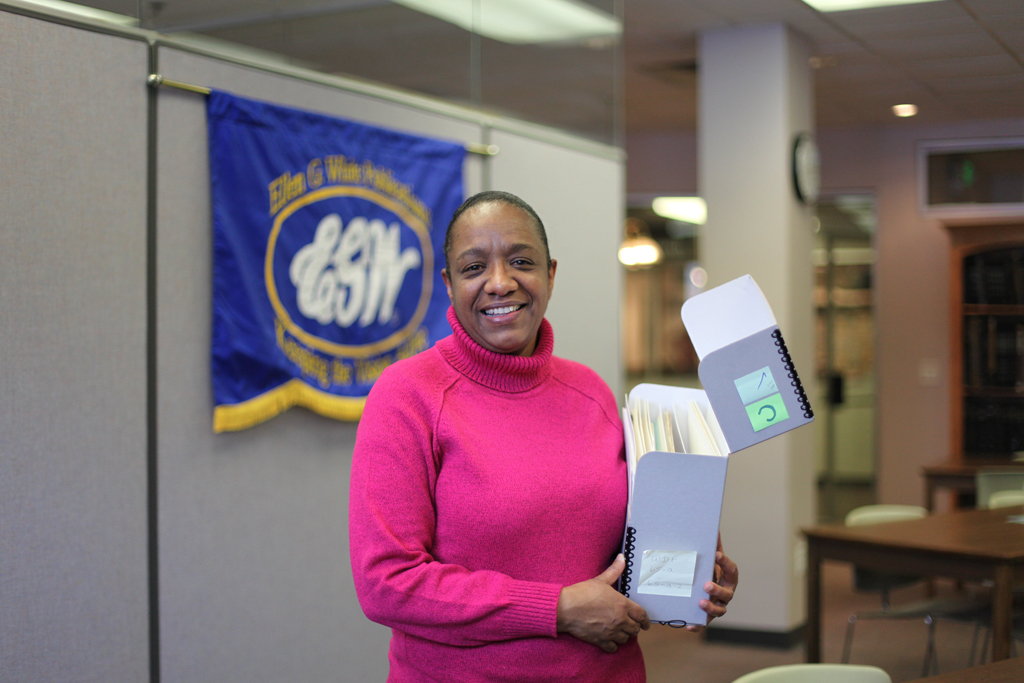In fall 2010 we began an ambitious project to catalog and better manage and preserve the Ellen G. White Document Files (WDF). This collection originated as the office file for Ellen White many years ago. It is a collection of clippings, papers, photocopies and other information gathered on a variety of topics. The original is in most cases at the main White Estate office at the General Conference building in Silver Spring, Maryland. Many of the White Document Files at the Center mirror the main office. However, our files often contain much more and/or different material than does the main office file. For years we’ve relied on a card index to access the contents of the files. Several years ago we were able to get the file titles into the Library’s catalog. But from the catalog we still did not know what was actually in the files.
Debbie Willock has worked on this large and complex task since the beginning. She feels she will be able to complete her part of the work by May 2014. She is listing all of the contents of each Document File in the Library’s online catalog. This will allow searching by title of the file, by the title of the individual items, as well as by keyword searching for any word appearing in the title, subject heading, and content note field.
Debbie’s approach to this work is to work through the entire collection looking for certain type of materials such as photographs, publications, term papers, and other materials which require different treatment. Some of these were removed and others were managed in different ways. This took more time at the beginning but at the end Debbie is left with less to do so the last stages should proceed faster. It is a large project, but one we anticipate will be used and appreciated by our researchers here and around the world. In fact the White Estate is tentatively planning to download the end result into their online Document Resource Center which will make this resource available to the world through the White Estate web site.
After indexing or cataloging the file contents the natural next step is to digitize them. We began this in 2012. Digitizing a collection is very time intensive since we need to remove staples and treat each document or folder as a separate file. This is a rather tedious process as each document, whether one page or 100 pages, is treated as an independent item. Then we need to link the scanned images to the collection register. Once the contents are scanned the Digitization Manager works with the System Librarian, Steve Sowder, to insert the PDF of each document into a web page. This web page is then what is attached to the Library Catalog and made available to researchers. Currently there are 2,417 linked WDF electronic files in the James White Library catalog.
Due to issues with changing organization and some resulting confusion we have temporarily suspended digitization until the organizing phase of the work is further along. Debbie is still finding documents and other items which need to go into what she thought were already done files. When Debbie finishes the organization and cataloging this year digitization can resume.
This project is a huge task. Most people do not realize the enormity of the work. The procedure sheet is nine pages in itself. When Merlin Burt was at the Loma Linda University White Estate Branch Office in the 1990s they undertook a similar but much less ambitious project and it took them quite a few years to get through a smaller number of files. Debbie is a determined and focused worker who sets goals for herself and works diligently to meet them. She has been hampered by an evolving set of procedures and by waiting for others to try to keep up with her when they need to do something to keep her work moving along.

White Document File boxes in their storage location in the stacks area of the Center for Adventist Research.
In recent years Angelika Kaiser, and now Heidi Magesa, spent considerable time reviewing Debbie’s listing of the file contents on the library catalog for accuracy and completeness. Then Camille Clayton did a final quick review looking for obvious spelling problems and other things that may have been missed by Debbie, Angelika, and Heidi’s review. Camille also assigns necessary subject headings to make the WDF’s easier to find by those doing subject searches.
Debbie Willock has been working on the White Document File for over three years during her time at the Center. Over time the project has changed in focus and procedures, but through it all Debbie has been a diligent and precise worker. She is very dedicated to this project and feels it is critical for young people to be aware of their denominational history. She believes this project takes important strides towards educating them. Thank you Debbie for a job well done.
Debbie Willock, an MDiv student, plans to graduate in August and hails from Windsor, Ontario, Canada.
Katy Wolfer, Special Projects Manager / Enjoys canoeing and kayaking and has been dunked in several Michigan rivers.
Jim Ford, Associate Director / Appreciates wide open spaces and can often be found walking to work.

